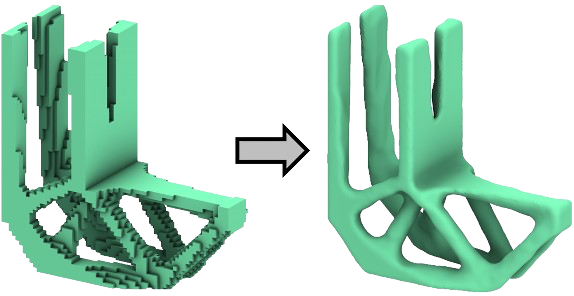As an innovative method, Peridynamics can model structural discontinuities in a realistic and practical way, thanks to the non-local relationships it defines between material particles. It creates a horizon for each particle and provides a communication channel by establishing bonds between the particles within it, as shown in the figure.
As a popular design method, Topology Optimization is frequently used for high efficiency and sustainability, especially in the aviation and automotive industries, thanks to the durable and lightweight structures it offers. It aims to lighten the initial design area in the most effective way, taking into account the operational conditions of the structure.
Combining the superior and unique features of the peridynamic method with topology optimization algorithms, PeriTopo differs from classical topology optimization methods in many points when designing durable and lightweight engineering structures. You can find PeriTopo's privileges and prominent features further down the page.
We maximize fracture toughness while lightweighting three-dimensional engineering structures with our particle-based topology optimization algorithms. According to the problem definition, we detect possible damage and high stress concentration regions during optimization and offer more resistant structures under both static and dynamic load conditions compared to conventional topology optimization methods.
The behavior of optimized structures obtained by classical methods and PeriTopo under dynamic load on L-beam and hanger beam examples is given. As can be seen, the design offered by PeriTopo visibly delays the occurrence of damage compared to the design suggested by classical methods.
We minimize residual stresses caused by rapid heating-cooling cycles during the additive manufacturing of metal engineering parts. We provide the residual stress regions determined by thermo-mechanical simulations as boundary conditions to the PeriTopo software. In this way, PeriTopo prevents possible damage by including areas that may be subject to distortion and production defects in the topology optimization problem. As a result, with Peritopo, we offer structures that deform less under the same load and are more resistant to damage caused by possible residual stress compared to traditional designs.


While using Peritopo, we lighten the structural elements of large-scale transportation vehicles used in the automotive, aviation and maritime industries, while offering maximum load-carrying capacity and fracture toughness in the final design. In this way, we contribute to the low carbon emission and sustainability targets of these industries by supporting low fuel and energy consumption.
We are showcasing an example ship mid-block design that we optimized with PeriTopo. The structure, which was optimized by considering the critical load situations that the ship may encounter during navigation, is approximately 20% lighter than the classical cross-section design, but carries 40% less strain energy. With PeriTopo, it is possible to effectively lighten large-scale structural elements, especially of air and marine vehicles.
The materials and printer types used in the field of additive manufacturing are increasing their diversity day by day. We can perform prototyping and experimental tests using both thermoplastic and metal materials. We first convert the optimization results we obtain with Peritopo into a solid model, and then we make these geometries ready for production by smoothing them.
We produce the sample bracket geometry that we optimized with Peritopo using the metal additive manufacturing method and carry out mechanical tests using fixtures suitable for the operational boundary conditions of the structure. On the other hand, we compared the performance of PeriTopo with classical methods in an experimental environment by producing it from PLA material using the FDM method. It has been proven from the load-deformation curves that the structures optimized with PeriTopo are more rigid. With PeriTopo, it is possible to lighten various engineering structures for different materials to obtain more durable designs compared to classical methods.

We take into account the production limitations of existing methods used in the field of additive manufacturing, and with PeriTopo, we design lightweight and durable structures while minimizing support structures. In this way, we save a lot of raw materials.
